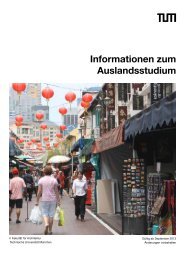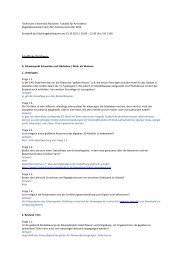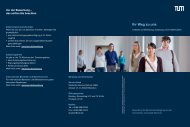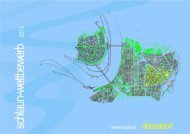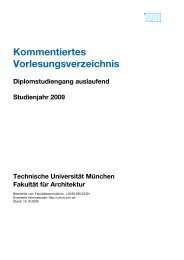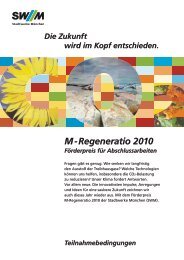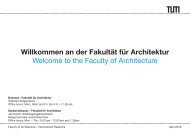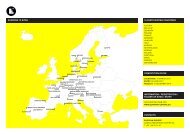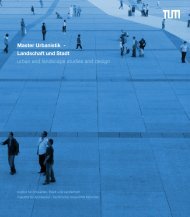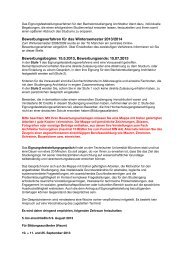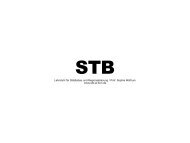Institute Institutes - Fakultät für Architektur - TUM
Institute Institutes - Fakultät für Architektur - TUM
Institute Institutes - Fakultät für Architektur - TUM
Sie wollen auch ein ePaper? Erhöhen Sie die Reichweite Ihrer Titel.
YUMPU macht aus Druck-PDFs automatisch weboptimierte ePaper, die Google liebt.
Semester Semester<br />
SS 2009, WS 2009/10<br />
Verfasser Author<br />
Elisabeth Adam, Alexander v. Angerer, Ursula<br />
Huber, Hannes Maier, Steffen Müller, Philipp<br />
Rataczjak, Verena Schmidt, Senada Thana,<br />
Adrian v. Vever, Roemer Warners, Tobias Weise,<br />
Martin Zschenkel<br />
Entwurf am Lehrstuhl <strong>für</strong> Städtebau und<br />
Regionalplanung<br />
Design at the Chair of Urban Design and<br />
Regional Planning<br />
Master <strong>Architektur</strong> Master Architecture<br />
Toolbox – Bauen in Ruanda<br />
Ruanda – eines der beeindrucktesten Länder dieser Erde verfügt durch seine geographische<br />
Lage, unweit des Äquators und auf einer Höhe von etwa 1500m N.N.<br />
gelegen, über ein sehr ausgeglichenes Klima. Nach einer durch Gewalt geprägten<br />
Geschichte, hat Ruanda die Vision sich 2020 aus den Fängen der Armut befreit zu<br />
haben und zu einer weltweit agierenden Handelsmetropole heranzuwachsen. Im<br />
Zuge dessen steigen die Aktivitäten im Bausektor stark an wobei man ausschließlich<br />
auf importiertes Know-How der westlichen Welt angewiesen ist. Durch den<br />
Aufbau einer Baufakultät am Kigali <strong>Institute</strong> for Science and Technology soll nun<br />
Wissen im eigenen Land gefördert werden. Bei einem Aufenthalt vor Ort wurde<br />
neben der Unterstützung zu diesem Aufbau zugesichert, einen Entwurf mit Studierenden<br />
der <strong>TUM</strong> <strong>für</strong> einen neuen Campus zu veranstalten. Wie baut man klimagerecht<br />
in Ruanda, um keine Energie zur Klimatisierung der Gebäude zu benö-<br />
bautypen<br />
tigen? Mit dieser Frage haben sich die Studierenden zu Beginn des Entwurfes<br />
intensiv auseinandergesetzt und eine Toolbox entwickelt, RIBBON die einzelne SHAPED Maßnahmen,<br />
wie Orientierung, Dichte, Typologie, Material oder Fensterflächenanteil im<br />
Kontext des zentralafrikanischen Klimas betrachtet und bewertet. Somit können<br />
in der Entwurfsphase Ansätze entwickelt werden, die in der Ausarbeitung Strukturen<br />
und Gebäude entstehen lassen, die dem Nutzer mit einem Minimum an Technik<br />
ein Maximum an Behaglichkeit bieten. Im zweiten Schritt wurde anhand der<br />
entstandenen räumlich städtebaulichen Planung ein Baustein weiterentwickelt. +<br />
Entstanden sind vor allem Gebäude ohne dichte Fassaden, mit massiven innenlie-<br />
ausrichtung<br />
genden Kernen, die tagsüber Wärme speichern und bei kühlen Nachttemperaturen<br />
abgeben, basierend auf der vorhandenen Ventilation in + der cross Nacht ventilation und einer nicht<br />
zu starken Aufheizung im Tagesverlauf. Dieser wurde entgegengewirkt + construction (little durch spans) die<br />
Ausblendung der direkten Sonneneinstrahlung und Nutzung + suffient der diffusen illumination Strahlung<br />
zur optimalen Belichtung.<br />
+ minimization of east / west exposure<br />
Toolbox – Building in Rwanda<br />
erschließung<br />
Rwanda, one of the most impressive countries on earth, - has not a convenient very balanced for certain cli- uses (f.e. audimax)<br />
mate due to its geographical position not far from the equator and about 1500 m<br />
above the sea level. After a historical period denoted by violence, Rwanda has set<br />
the vision to become free from poverty and to develop to a global business megacity<br />
by 2020. As part of it, the activities related to the construction sector are<br />
increasing rapidly although those are exclusively depending on imported knowhow<br />
from occidental countries. Through the constitution konstruktion of an architecture faculty<br />
at the Kigali <strong>Institute</strong> for Science and Technology, knowledge is expected to<br />
be promoted in their own country. During a stay in Kigali the planning process<br />
was supported and students of the <strong>TUM</strong> had the opportunity to participate to a<br />
design for a new campus. How can be built in Rwanda to reduce energy consumption<br />
for the conditioning of buildings? Students have handled this question and<br />
have developed a toolbox which evaluates several measures as orientation, density,<br />
typology, material, glazed surface ratio, in relation to the central African<br />
climate. This tool allows the development of different approaches in the very first<br />
planning phase which generate structures and buildings that can guarantee high<br />
comfort levels with a minimal use of technical supply systems. In the second phase<br />
a building was designed based on the resulting urban structures: buildings without<br />
dense facades, with massive cores, which can store heat during the day and emit<br />
it by cool night temperatures through natural ventilation. Through the shading of<br />
the direct solar radiation overheating is opposed and diffused light guarantees<br />
optimal visual comfort.<br />
-<br />
RIBBON SHAPED<br />
90 Bauklimatik und Haustechnik Building Climatology and Building Services<br />
Auszug aus Climatoolbox – Leitfaden zum klimagerechten Bauen in Ruanda Excerpt from<br />
Climatoolbox - Guide to climate friendly building in Rwanda<br />
Sonnenstandsdiagramm Kigali Sun chart Kigali<br />
Modellfoto zum Entwurf der Mensa <strong>für</strong> den neuen Campus des „Kigali Instituts for Science<br />
and Technology Photo model for the design of the canteen for the new campus of the „Kigali<br />
<strong>Institute</strong> of Science and Technology“ S. Müller / A. von Angerer<br />
91<br />
dichte<br />
bautypen<br />
+<br />
ausrichtung<br />
+ minimization of east / west exposure<br />
+ cross ventilation<br />
+ construction (little spans)<br />
+ suffient illumination<br />
-<br />
erschließung<br />
dichte<br />
- not convenient for certain uses (f.e. audimax)<br />
konstruktion<br />
Since their well-defined orientation ribbon-shaped buildings<br />
allow an easy handling of sun-path conditions.<br />
Narrow building sides should be oriented to east and<br />
west under Kigali’s climate conditions. Large windows<br />
should be avoided on these two fronts. Due the slight<br />
wave angle of the sun, solar radiation would reach<br />
quite deep into the building’s interior.<br />
While moving of the sun to north and south respectively<br />
the angle is getting steeper, which just requires<br />
minor sun protection measurements.<br />
The width of the ribbon should be considered very<br />
well. A wide building shape reduces the quantity of<br />
natural daylight in the buildings’ interior and requires a<br />
more complicated construction system.<br />
Nevertheless slim ribbons are not helpful for all kinds<br />
of usages.<br />
N<br />
0°<br />
20°<br />
40°<br />
Since their well-defined orientation ribbon-shaped buildings<br />
allow an easy handling of sun-path conditions.<br />
Narrow building sides should be oriented to east and<br />
west under Kigali’s climate conditions. Large windows<br />
should be avoided on these two fronts. Due the slight<br />
wave angle of the sun, solar radiation would reach<br />
quite deep into the building’s interior.<br />
While moving of the sun to north and south respectively<br />
the angle is getting steeper, which just requires<br />
minor sun protection measurements.<br />
The width of the ribbon should be considered very<br />
well. A wide building shape reduces the quantity of<br />
natural daylight in the buildings’ interior and requires a<br />
more complicated construction system.<br />
Nevertheless slim ribbons are not helpful for all kinds<br />
of usages.<br />
21.06<br />
21.12<br />
15.03<br />
125




